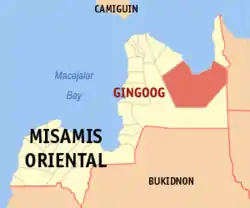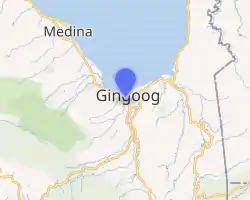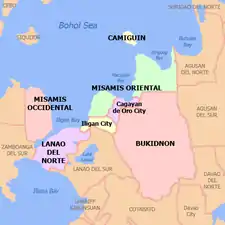Gingoog
Gingoog, officially the City of Gingoog (Cebuano: Dakbayan sa Hingoog; Filipino: Lungsod ng Hingoog), is a 2nd class component city in the province of Misamis Oriental, Philippines. According to the 2015 census, it has a population of 124,648 people. [3]
Gingoog | |
|---|---|
| City of Gingoog | |
 Skyline view of Gingoog | |
 Seal | |
| Nickname(s): City of Good luck | |
 Map of Misamis Oriental with Gingoog highlighted | |
OpenStreetMap 
| |
.svg.png.webp) Gingoog Location within the Philippines | |
| Coordinates: 8°49′N 125°06′E | |
| Country | |
| Region | Northern Mindanao (Region X) |
| Province | Misamis Oriental |
| District | 1st District |
| Settled | 1750 |
| Incorporated | 1908 |
| Cityhood | June 18, 1960 |
| Barangays | 79 (see Barangays) |
| Government | |
| • Type | Sangguniang Panlungsod |
| • Mayor | Erick Generales Cañosa |
| • Vice Mayor | Peter "Sr. Pedro" M. Unabia |
| • Representative | Christian S. Unabia |
| • Councilors |
|
| • Electorate | 86,072 voters (2019) |
| Area | |
| • Total | 568.44 km2 (219.48 sq mi) |
| Elevation | 476 m (1,562 ft) |
| Population | |
| • Total | 124,648 |
| • Density | 220/km2 (570/sq mi) |
| • Households | 26,307 |
| Economy | |
| • Income class | 2nd city income class |
| • Poverty incidence | 29.64% (2015)[4] |
| • Revenue | ₱766,410,433.59 (2016) |
| Time zone | UTC+8 (PST) |
| ZIP code | 9014 |
| PSGC | |
| IDD : area code | +63 (0)88 |
| Climate type | tropical climate |
| Native languages | Cebuano Binukid Subanon Tagalog |
| Website | www |
Like other municipalities in the Philippines that retained Spanish-based orthography, the city name is spelled as Gingoog but is pronounced as ['hiŋuʔog] or HEE-ngu-og since it originated as a Binukid word.
Geography
Gingoog is located in the Province of Misamis Oriental in the Northern Mindanao Region on Mindanao island. The city is approximately 122 kilometres (76 mi) east of Cagayan de Oro City and 74 kilometres (46 mi) west of Butuan City. It is bounded on the east by the Municipality of Magsaysay; on the west by the Municipality of Medina; on the south by the Municipality of Claveria; and on the north by Gingoog Bay. Its total land area is 56,844 hectares (140,460 acres).
Climate
| Climate data for Gingoog City, Misamis Oriental | |||||||||||||
|---|---|---|---|---|---|---|---|---|---|---|---|---|---|
| Month | Jan | Feb | Mar | Apr | May | Jun | Jul | Aug | Sep | Oct | Nov | Dec | Year |
| Average high °C (°F) | 28 (82) |
28 (82) |
29 (84) |
30 (86) |
30 (86) |
30 (86) |
30 (86) |
30 (86) |
30 (86) |
29 (84) |
29 (84) |
28 (82) |
29 (85) |
| Average low °C (°F) | 23 (73) |
23 (73) |
23 (73) |
23 (73) |
25 (77) |
25 (77) |
25 (77) |
25 (77) |
25 (77) |
25 (77) |
24 (75) |
24 (75) |
24 (75) |
| Average precipitation mm (inches) | 327 (12.9) |
254 (10.0) |
185 (7.3) |
128 (5.0) |
215 (8.5) |
273 (10.7) |
248 (9.8) |
243 (9.6) |
214 (8.4) |
246 (9.7) |
271 (10.7) |
271 (10.7) |
2,875 (113.3) |
| Average rainy days | 24.3 | 21.1 | 22.5 | 20.6 | 28.3 | 28.8 | 29.4 | 29.0 | 28.0 | 28.3 | 26.0 | 24.2 | 310.5 |
| Source: Meteoblue [5] | |||||||||||||
Barangays
Gingoog City is politically subdivided into 79 barangays. In 1957, the sitio of Malibod was converted into a barrio.[6]
The 79 barangays are the following:
- Agay-ayan
- Alagatan
- Anakan
- Bagubad
- Bakidbakid
- Bal-ason
- Bantaawan
- Binakalan
- Capitulangan
- Daan-Lungsod
- Dinawehan
- Eureka
- Hindangon
- Kalagonoy
- Kalipay
- Kamanikan
- Kianlagan
- Kibuging
- Kipuntos
- Lawaan
- Lawit
- Libertad
- Libon
- Lunao
- Lunotan
- Malibud
- Malinao
- Maribucao
- Mimbuntong
- Mimbalagon
- Mimbunga
- Minsapinit
- Murallon
- Odiongan
- Pangasihan
- Pigsaluhan
- Punong
- Ricoro
- Samay
- Sangalan
- San Jose
- San Juan
- San Luis
- San Miguel
- Santiago
- Tagpako
- Talisay
- Talon
- Tinabalan
- Tinulongan
- Barangay 1
- Barangay 2
- Barangay 3
- Barangay 4
- Barangay 5
- Barangay 6
- Barangay 7
- Barangay 8
- Barangay 9
- Barangay 10
- Barangay 11
- Barangay 12
- Barangay 13
- Barangay 14
- Barangay 15
- Barangay 16
- Barangay 17
- Barangay 18
- Barangay 18-A
- Barangay 19
- Barangay 20
- Barangay 21
- Barangay 22
- Barangay 22-A
- Barangay 23
- Barangay 24
- Barangay 24-A
- Barangay 25
- Barangay 26
History
The term Gingoog originally came from the word "Hingoog", which means "Goodluck", from a Lumad tribe of Manobo who settled in the area.[7] The word implies good fortune, thus Gingoog City means the City of Good Luck. The natives of this place are the ones with the family names of "Gingco", and "Gingoyon".
Gingoog was founded as a mission by Spanish missionaries in 1750. It was one of the oldest localities in Misamis Oriental Province, older than the province's capital and economic hub, Cagayan de Oro which was founded in 1871. It was made part of the town of Talisayan until it was incorporated as an independent municipality in 1908.
In 1957, the sitio of Binuangan was converted into a barrio known as Talisay.[8]
Gingoog was turned into a city via Republic Act No. 2668 signed by President Carlos P. Garcia circa June 18, 1960.[9]
Demographics
|
| ||||||||||||||||||||||||||||||||||||||||||||||||
| Source: Philippine Statistics Authority [3] [10] [11][12] | |||||||||||||||||||||||||||||||||||||||||||||||||
Economy
The city's total income during year 2000 reached P296,731.65, of which 292,077.262.40 or 98.43% accrued in the General Fund while P4,653,809.25 or 1.5% accrued in the Special Education Fund. Comparatively, the 1999 income level of P250.64 Million has increased by P46.09 Million or 18.39%. The biggest bulk of the city's income was derived from tax revenues complementing around 95.5% of the total earnings of the year. One major component of this income class is the Internal Revenue Allotment (IRA) which contributed a total amount of P259.69 Million or 93.04%. Said IRA has increased by P37.43 Million or 16.83% against that of 1999. Local revenue contributed only 10.04% of the City's total annual income.
Total expenditure incurred by the city for the whole year reached to about P243.54 Million, of which P239.66 Million was spent from the General Fund and P3.88 Million was spent from the Special Education Fund. Comparatively, an increase of about P9.76 Million or 4.17% over 1999.
By expense class, personal services absorbed as much as P161.74 Million or 66.41%. That includes the services of the devolved employees, newly created positions as mandated by R.A. 7160 and project engaged workers. Maintenance and other operating expenses followed with P45.35 Million, or 18.62%, then Capital Outlay with P36.46 Million, or 14.97%.
References
- City of Gingoog | (DILG)
- "Province: Misamis Oriental". PSGC Interactive. Quezon City, Philippines: Philippine Statistics Authority. Retrieved 12 November 2016.
- Census of Population (2015). "Region X (Northern Mindanao)". Total Population by Province, City, Municipality and Barangay. PSA. Retrieved 20 June 2016.
- "PSA releases the 2015 Municipal and City Level Poverty Estimates". Quezon City, Philippines. Retrieved 12 October 2019.
- "Gingoog: Average Temperatures and Rainfall". Meteoblue. Retrieved 29 April 2020.
- "An Act Creating a Certain Barrio in the Municipality of Gingoog, Province of Misamis Oriental". LawPH.com. Archived from the original on 2012-07-11. Retrieved 2011-04-12.
- Gingoog
- "An Act Creating the Barrio of Talisay, Municipality of Giñgoog, Province of Misamis Oriental". LawPH.com. Archived from the original on 2012-07-14. Retrieved 2011-04-12.
- Proclamation No. 686, s. 1960: Republic Act No. 2668
- Census of Population and Housing (2010). "Region X (Northern Mindanao)". Total Population by Province, City, Municipality and Barangay. NSO. Retrieved 29 June 2016.
- Censuses of Population (1903–2007). "Region X (Northern Mindanao)". Table 1. Population Enumerated in Various Censuses by Province/Highly Urbanized City: 1903 to 2007. NSO.
- "Province of Misamis Oriental". Municipality Population Data. Local Water Utilities Administration Research Division. Retrieved 17 December 2016.
External links
| Wikimedia Commons has media related to Gingoog. |
| Wikivoyage has a travel guide for Gingoog. |

